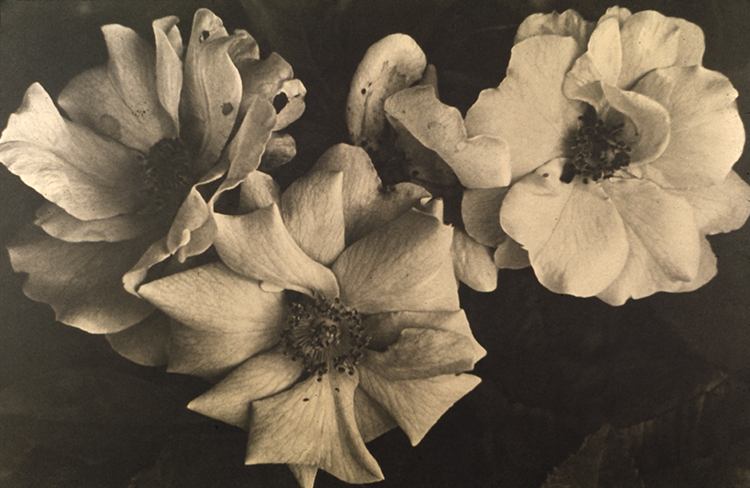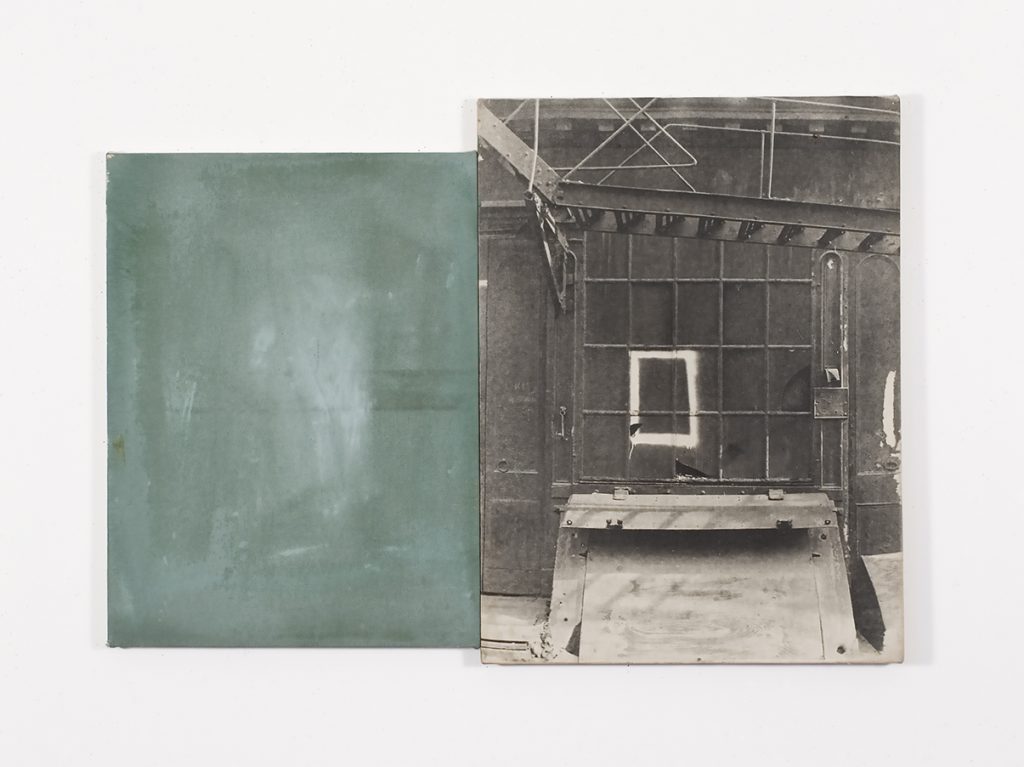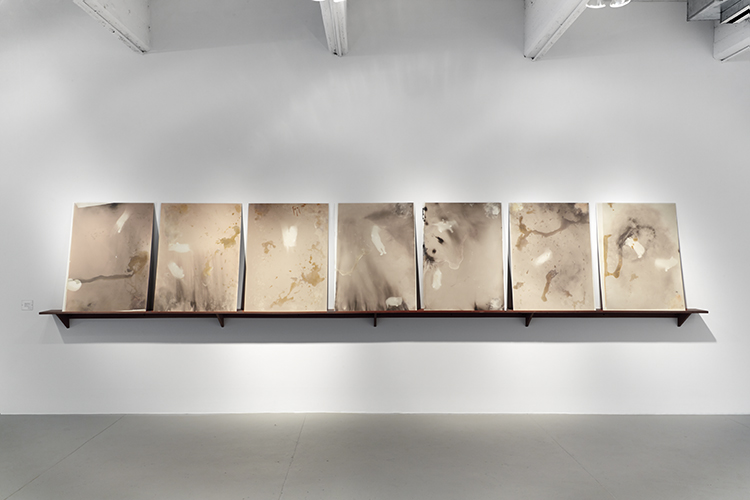杉浦邦恵 SUGIURA Kunié
 《電気服にちなんで Ap2、黄色》2002年 ゼラチンシルバープリント 175.3×113.0cm
《電気服にちなんで Ap2、黄色》2002年 ゼラチンシルバープリント 175.3×113.0cm
after Electric Dress Ap2 Yellow, 2002, Gelatin silver print, 175.3×113.0cm
杉浦邦恵
SUGIURA Kunié
1942年、愛知県名古屋市生まれ ニューヨークに在住、活動
長い間、杉浦邦恵という作家のことが不思議だった。1960年代に単身渡米し、シカゴ美術学校でニューバウハウスの流れを汲む写真教育を受けた。卒業後ニューヨークに拠点を移し、以来今日に至るまでフォトカンヴァスやフォトグラムなどによる実験的な作品を意欲的に作り続けてきた。そうした作家活動の一方で、80年代からは美術雑誌にニューヨークのアートシーンについて数多く寄稿してもいる。このように説明すれば、彼女が日本という枠にも狭義の写真という枠にもとらわれず、ときにはアーティストという立場にすら固執しない、好奇心旺盛で自由な精神の持ち主であることがわかる。そうやって世界一競争の激しい都市のアートシーンを生き残ってきたのだから、さぞかしパワフルで活動的な人なのだろうと想像してしまう。
こちらのそんな憶測を心地よく裏切るかのように、彼女の作品にはつねに息を呑むほどの静寂が漂う。その静寂とは、徹底してひとりであろうとする者だけが獲得し得る繊細さのようなもの、と言えるかもしれない。周囲の雑音をすっと断ち切り、透徹したまなざしで生のありようを俯瞰すると同時に、個別の生へ体当たりする生々しさも手放さない。その両義的ともいえる制作へのアプローチは、彼女が中心的に用いる技法であるフォトグラムによる作品にもっともよく表れている。フォトグラムはカメラを使わず、光を遮断した暗い部屋で制作される。彼女はそこで時間をかけて、生花やウナギ、子猫など、様々な生き物を観察し、けっしてとどまることのないそれらの影を――ときに艶かしくさえある生の痕跡を――印画紙へ落とし込む。そうやって彼女が作り出すイメージの中では、誰もが胎内にいるかのように傷つきやすく、ひとりきりだ。あらゆる生の出発点は、このような場所だったことをつくづく思い起こさせられる。
90年代以降になると、そのフォトグラム作品には草間彌生、ジャスパー・ジョーンズ、村上隆といった著名なアーティストが登場するようになった。この変化はやや意外にも思える。明らかに個性的なアーティストたちとのコラボレーションは、それまで無名の存在と向き合ってきた杉浦の作品に見られた孤独さや静寂さとは一見相反するように思えるからである。しかし改めて見てみると、どうだろう。自ら反射する光を奪われ、単なる影となった彼らの姿は、そのジェスチャーによってかろうじてアイデンティティを保持している。しかしひとり影であるという点では、他のあらゆる存在と何ら変わらない。杉浦はもしかすると、アーティストというアイデンティティすらいったん手放して、あらゆる生がめぐりめぐる円環の中に彼らを、そして自らをも置こうとしているのかもしれない。彼女のまなざしのもとでは、人間の創造性の頂点に立つと言われる存在たちも、まるで作品を見ている者の影のように、生きること、そして作ることの意味を、静寂の中で絶えず問いかけてくる。
竹内万里子「展覧会によせて」、「杉浦邦恵」展、ART OFFICE OZASA、京都、2020年3-6月
Born in Nagoya, Aichi, Japan, 1942. Lives and works in New York.
The artist Sugiura Kunie was a mystery to me for many years. She moved to the United States in the 1960s, and studied photographic education based on the Bauhaus at the Art Institute of Chicago. After graduation she moved to New York City. Up until today she has actively created experimental works through adopting the methods of photo-canvas printing and photograms. Aside from her artistic activities, Sugiura has also contributed numerous articles on the New York art scene to a Japanese art magazine since the 1980s. These descriptions allow one to understand that she is a free-minded person, full of curiosity, who at times does not even adhere to the position of being an artist. Nor is she confined within the framework of Japan or a narrow definition of photography. I imagine that with that mindset, she must be an awfully powerful and active person, since she has survived through many years in the world’s most competitive city for art.
As if to pleasantly disappoint my speculations, a breathtaking sense of serenity is always inherent in her works. That serenity can be explained as something like a subtle feeling that can only be obtained by one who thoroughly seeks to be a solitary individual. Sugiura completely shuts out the surrounding noises, and then takes a bird’s-eye view of the state of life with her penetrating eyes. Nonetheless, she maintains a sense of vividness that derives from immersing herself in the life of each individual life-form she works with. This production approach that can be seen as encompassing dual meanings is best manifested in her photograms, a medium that she has predominantly employed. A photogram does not involve the use of a camera but is produced in a darkroom via blocking light. Inside that room, she takes her time to observe a variety of life forms, such as flowers, an eel or a kitten. She then captures on photographic paper their constantly moving shadows—that is, the traces of life that at times even reveal a seductive appearance. In every one of those images produced through such a process, she conveys a sense of vulnerability and solitude, as if they were inside a womb. This allows one to keenly recall that the threshold for all life forms is similar to that type of place.
From the 1990s onward, prominent artists such as Kusama Yayoi, Jasper Johns and Murakami Takashi began to appear in her photograms. This shift was rather unexpected. This is because Sugiura’s collaborations with these apparently unique artists seemed to conflict with the sense of solitude and tranquility that were typically inherent in her works, which had focused on anonymous existences up until that time. But what can a closer look at this series tell us? The appearances of the artists became mere shadows as a result of their being deprived of the light that would have reflected their bodies. Thus, their own identities were maintained only through their respective unique postures. But from the perspective that each work consists of the single shadow of a person, those artists are no different from all other existences. It just might be that Sugiura had temporarily given up her identity as an artist so that she could position those artists and herself within the circulative pathway where all lives ceaselessly flow. Under her gaze, even those artists who are said to be at the summit of human creativity seem to continually question in silence the meanings behind “living” and “creating,” as if they were the shadows of those viewing the works.
Takeuchi Mariko, On Her Exhibition: Sugiura Kunie, ART OFFICE OZASA , Kyoto, March – June 2020 (Translated by NANPEI Taeko)
更新された最新の情報は、作家のウェブサイトをご覧ください。
Please refer to the artist’s website for new updates.
AWARE: Archives of Women Artists, Research & Exhibitions
https://awarewomenartists.com/en/artiste/kunie-sugiura-2/
AWARE-日本

《3本のバラ》1969年 写真乳剤、グラファイト、カンヴァス 97.0×145.0cm
Three Roses, 1969, Photo emulsion, graphite on canvas, 97.0×145.0cm

《市場の前面》1978年 写真乳剤、アクリル絵具、カンヴァス 61.0×86.4cm
Marketfront, 1978 , Photo emulsion, acrylic on canvas, 61.0×86.4cm

《子猫の書類》1992年 7点のアルミマウントされたゼラチン・シルバー・プリント、特製の木の棚、テキスト 122×601×18 cm(全体)
The kitten papers, 1992, 7 Gelatin silver prints on aluminum, Wood shelf with Text, 122×601×18 cm (total)
All photos credit : SUGIURA Kunié

